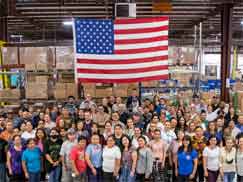There aren’t very many shoe companies left producing domestically, with most brands having fled to China or other Asia decades ago.
While there are still dozens of US shoe makers in absolute terms, most are small, or are larger companies, such as New Balance, that source domestically for a very limited range of shoes.
A few bigger names, such as Red Wing Boots and LL Bean, also make a portion of their SKUs in the US.
Supply Chain Digest Says...
|
 |
“It is imperative industry and retail move toward a circular-based economy,” said Irvani in conclusion. “That’s not something that just happens or falls from the sky.
|
 |
What do you say? |
| Click here to send us your comments |
 |
| |
|
But domestically-made shoes account for only about 1% of US shoe revenue.
One of the smaller shoe makers still getting it done domestically is Okabashi, based in Buford, Georgia. It may be best known for its sandals, but has other sizes as well – all made in he US.
As recently profiled on the web site of the National Association of manufacturers (NAM), Okabashi said it survives and even thrives though a focus on sustainability and (relatedly) a major focus on R&D.
The family-owned company was started 40 years ago, and says it always focused on reducing waste, both for the positive environmental impact as well as to improve its bottom line.
“By developing closed-loop manufacturing processes, we were able to reuse some of the materials that otherwise might have gone to waste,” says third-generation shoemaker Sara Irvani “That helped us stay more competitive—and from there we’ve developed innovations in processes and systems and materials that build on that foundation.”
Okabashi’s sustainable processes extend throughout the product lifecycle—from incorporating recycled or biological elements (like soy) that ensure products last longer to preventing disposable waste to recycling post-consumer shoes into new ones.
“When we look at sustainability of a product, we do it holistically—we look at what it’s made of, where it’s made, how it’s made, the lifecycle, the quality—and we’ve been able to innovate and develop so that our manufacturing process doesn’t create waste,” said Irvani.
She adds that “Without R&D, we would not only be creating the additional cost basis of throwing away all those scraps, but we would also not be able to eliminate waste that is by default landfill or ocean bound.”
A New Focus on Circularity
In the traditional, linear economic model, inputs go into production, a product reaches a consumer, and the consumer uses the product and eventually throws it away. In contrast, Okabashi is working to perfect a circular economic model for its products, where all materials are reused, repurposed, or recycled, including from the end consumer level.
“If you are designing for circularity, you might use renewable and recycled resources, develop them into that same product with a level of quality that lasts longer, and when the customer is ready to move on, it can be remade into something else,” Irvani says. “That’s how the loop continues. When we talk about circularity, we’re creating that virtuous cycle.”
(See More Below)
 “To remake and recycle a product into something new, you need to have local production,” Irvani noted. “You can’t be sending things halfway across the world to be unmade and remade and sent back. That’s why R&D locally and domestically is so important, to help produce circular systems.” “To remake and recycle a product into something new, you need to have local production,” Irvani noted. “You can’t be sending things halfway across the world to be unmade and remade and sent back. That’s why R&D locally and domestically is so important, to help produce circular systems.”
More generally, Irvani believes R&D is essential for US companies competing with manufacturers abroad.
“For US manufacturing broadly, R&D is critical to stay at the forefront of the innovation curve,” said Irvani. “Unless we’re proactively investing and developing new and better ways of doing things, we won’t be globally competitive.”
“It is imperative industry and retail move toward a circular-based economy,” said Irvani in conclusion. “That’s not something that just happens or falls from the sky. Consumers are demanding it, and R&D is our pathway to that future.”
Nice story from NAM.
Any thoughts on Okabashi's story? Let us know your thoughts at the Feedback section below.
|